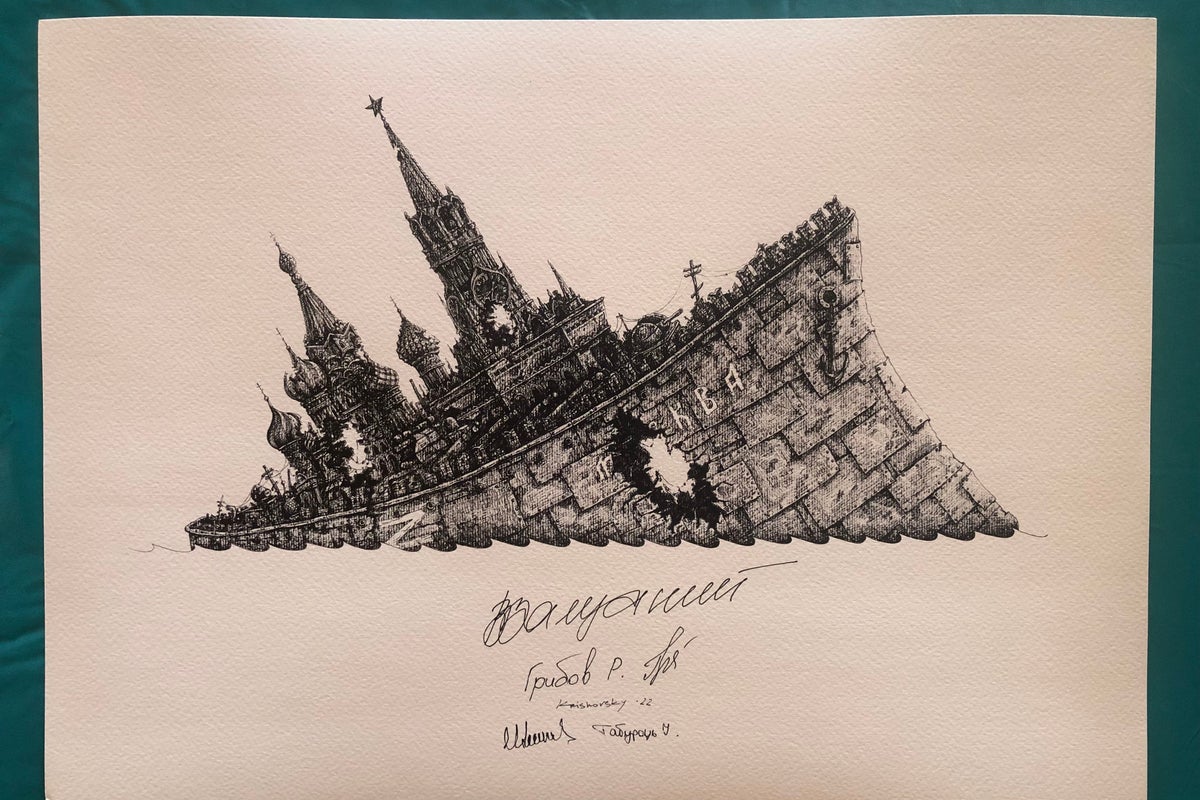
A Ukrainian artist is selling an ink artwork of the Russian warship which faced now-famous defiance from a border guard in the opening hours of the war, with the piece commissioned and signed by the man who spoke the famous words.
The phrase “Russian warship, go f*** yourself” was the last communication made on February 24 2022 during the Russian attack on Zmiinyi Island, or Snake Island in English, by border guard Roman Hrybov to the Moskva.
Mr Hrybov was decorated by the Ukrainian government for his bravery and the phrase has been used extensively in protests and demonstrations globally, even being commemorated on postal stamps.
The Moskva, the flagship of Russia’s Black Sea fleet, was later sunk on April 14 and graphic artist Dmytro Krishovsky met with Mr Hrybov and was commissioned by the war hero himself to produce an artwork of the sinking.
Part of his war-inspired black and white series called Motanka, which also includes depictions of artillery and AK-47s, Mr Krishovsky’s work has been signed by My Hrybov.
A year since Russia’s invasion, Mr Krishovsky hopes the collection will encourage people not to “close their eyes” to the horrors happening in his country.
“I met the guy (Roman Hrybov) who said the symbolic phrase of the Russian warship,” Mr Krishovsky, 34, told the PA news agency from a village 100km away from Kyiv via a translator.
“The guy asked me to draw the ship and put my artistic fingerprint on it and he signed the artwork.”
Describing his artwork, Mr Krishovsky said the name of the warship, which means Moscow in English, is “symbolic”, as is the ‘Z’ symbol, which has become a prominent feature in Russian propaganda and frequently marks the nation’s military equipment.
“It has the architectural elements of the Kremlin on top of it and represents that the whole state is a terrorist state,” Mr Krishovsky said.
“There is a crack to show that the warship and the whole terrorist state has been cracked and is going down by Ukrainian forces.”
The piece, which is called To The Russian Warship: Go F*** Yourself, is awaiting a bidder, while copies are being sold to raise funds for charities in Ukraine and to support Mr Krishovsky’s family.
The Motanka series regularly references or includes a traditional Ukrainian doll of the same name, which is wrapped in fabric and symbolises well-being and hope.
Oberig (The Guardian) shows a gun wrapped in the fabric the Motanka doll is usually covered in.
“The gun is the AK-47, which is used by 90% of our army and it’s wrapped in the scarf of the grandmothers,” he said.
“It protects us from something bad that could happen.
“Art shows my reflections and what is happening around me.
“Every artist should take responsibility and not show things as they were in peaceful times and let people know about our situation.”
Translating for Mr Krishovksy was Andy Verdi, the founder of UART Gallery, an online platform for Ukrainian artists and art lovers which Mr Krishovsky is part of.
Mr Verdi, 40, lives in Odesa and during the interview, which he translated from Ukrainian to English on behalf of Mr Krishovsky, the pair were alerted about an air raid siren outside via informers on their mobile phones.
They said they only have electricity for between two and four hours a day, often at night.
Mr Krishovsky added that he is “fed up to the teeth” of picking up his daughter from the bomb shelter when she is going to school.
Reflecting on February 24 2022, the day Russia invaded, Mr Krishovsky said “frost went on my arms”.
“I’m feeling the goosebumps, the return of that state of mind from last year,” he said.
“At four o’clock in the morning, when the first explosions sounded, I woke up and opened Facebook and saw many of my friends posted it had begun.
“My wife (Iryna, 30) came back to the room running and started to get the kids ready in pyjamas, barefoot.
“We took the cat, some belongings, the pet snail we bought the day before and ran to the car.”
His family spent some time in Poland and were reunited with Mr Krishovsky in Ukraine recently.
Mr Verdi said the bomb shelter holds some significance for him and his wife, Helen Labartkava-Verdi, 40.
“Me and my wife were sitting in the bomb shelter in March of last year and we had long discussions because we were sat for hours between the concrete walls about how we can be helpful”, Mr Verdi said.
“We are both artistic people and we thought we could run a gallery for Ukrainian contemporary young artists, get them together and build a platform where we can show their art to people all over the world.
“And I think we succeed because we set up UART Gallery and have more than 50 artists with authentic styles and have held more than 10 exhibitions and events over the globe.”
But the world has a choice, either help us to stand for the world's freedom or close your eyes, and we would like the world to continue to see and help us— Dmytro Krishovsky
“We are in the epicentre of the events and we have no choice,” Mr Krishovsky said.
“But the world has a choice, either help us to stand for the world’s freedom or close your eyes, and we would like the world to continue to see and help us.
“We are fighting on the artistic frontier, as well as volunteering and donating a significant part of our income to military and humanitarian purposes.”
For more information about the UART Gallery, visit uart.gallery/.







